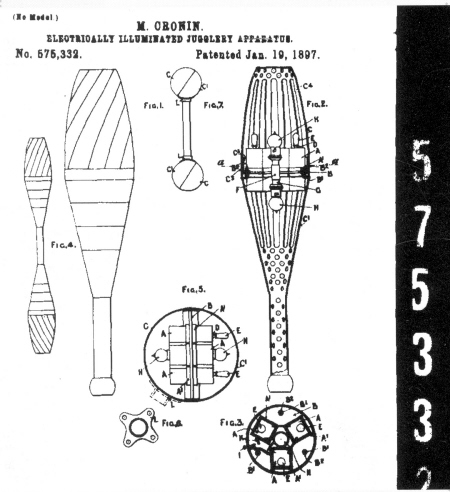Flashback
U.S.
Patent Office
Specification
forming part of Letters Patent
No. 575,332, Dated January 19, 1897
For
Electrically-Illuminated Jugglery Apparatus by Morris Cronin of
London, England
To
all whom it may concern:
Be
it known that I, Morris Cronin, a citizen
of the United States of America, residing in London, England, have
invented new and useful improvements in electrically illuminated
jugglery apparatus, of which the following is a specification.
This
invention consists in jugglery apparatus containing electric
glow-lamps and battery in the interior of a partly-transparent outer
envelop or frame, all so constructed that the apparatus can be
readily taken to pieces and put together and so that the gas evolved
during the performance, together with any acid that might escape
from the cells, shall be collected and retained within the apparatus
itself. The apparatus may assume various forms, such as a ball, a
club, or a wand with a ball or club at each end.
Figure
1 of the drawings is a side elevation, and Fig. 2 a longitudinal
section, of an Indian club for jugglery performance; and Fig. 3, a
section on line a-a, Fig. 2. Fig. 4 is a side view of a
double-ended club. Fig. 5 is a section through a ball-shaped
jugglery apparatus; Fig. 6, a detail of same, and Fig. 7 a side view
of a double-ended club with ball-shaped ends.
The
electric battery, by preference
a secondary battery of any known suitable construction, is made
with, say, three cells A, of ebonite or the like. These cells, in
this case shown square, are passed partly through and cemented into
corresponding square holes in a flange B and rest thereon with
flanges A', which are also cemented to the flange B. This latter is,
by means of studs B' and nuts B2, fixed to the outer envelope or
hollow frame, which is of club shape and made in two parts C and C'.
These parts are united by screws C2, screwed into a reinforcering
C3, united to the part C.
The
hollow frame C C' is made of sheet metal with perforations in the
form of slits C4 or round holes, or zigzag, or any other
regular, irregular, or fancy shape. These perforations are covered
on the inside or on the outside with some suitable transparent
material, such, for instance, as celluloid, by preference, in
various colors. If the transparent material is outside, it may form
an entire outer covering. In Fig. 1 the outer covering is shown in
the form of strips of celluloid, intended to be of various colors,
said strips being put on helically near the outer end of the club
and in rings of various colors, as to the rest the handle part may
be white.
Each
cell has a cover cemented in liquid tight, and each cover has an
inlet-tube D for charging or discharging the acid. Over a
flange on each tube is sprung a hollow rubber cap E, capable
of receiving the surplus gas pressure and expanding therewith during
the five or
ten minutes that the performance with the apparatus lasts. It is
also intended to receive
any drops of acid that might be projected .. through the compressed
gas on the top of the liquid in the cell.
The
foundation-plate or flange B has a central socket F, formed on or
fixed thereto and serving to receive the sockets G of two electric
glow-lamps II. The switch-rod and button I, when pushed in against
the contact K, closes the circuit and causes the lamps to burn; but
any other well-known form of switch may be used.
Fig.
4 shows a double-ended club, each en being of the construction
described.
Fig.
5 shows a section of a ball-shaped
frame in two halves for holding between them in the manner described
the flange or foundation-plate B with cells A and lamps II. This
ball is used for playing with, the same as the club. If the ball is
to be attached to a wand, such as, for instance, shown in Fig. 7,
which has a ball on each end, I provide the ball with a screw-socket
L. (Shown in dotted lines in Fig. 5 and in plan projection in Fig.
6.)
What
I claim as my invention, and desire to secure by Letters Patent,
is...
1.
Electric-light-transparency jugglery
apparatus, consisting of electric-battery cells provided with
expansible gas-receptacles over their filling-inlets, said cells
fixed to a foundation-plate of ebonite or the like having one or
more electric glow-lamps fixed thereto, and an outer inclosing
sheet-metal hollow frame made in detachable parts and within which
the said foundation-plate is fixed, said frame having holes provided
with colored transparent material and with a switch for turning the
light on or off, substantially as
set forth. 2. The combination of the electric-battery
cells A provided with hollow rubber caps E on their filling-tubes
D, the plate B to which the cells are fixed and which is provided
with sockets F, the glow-lamp sockets
G fixed therein and carrying the lamps II, the outer hollow
perforated sheet-metal frame C'
with screws B' and nuts B2 for fixing the plate B thereto, the outer
hollow perforated sheetmetal frame C detachably united to the
hollow frame C',
colored celluloid or the like covering the holes in the frame C C',
and a switch I K, substantially as set forth Morris Cronin

